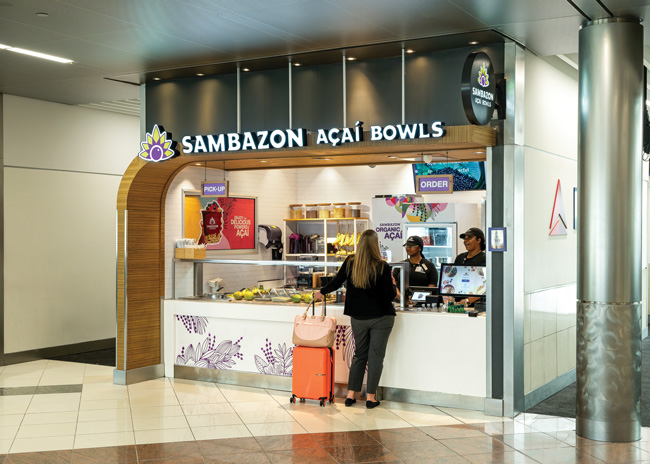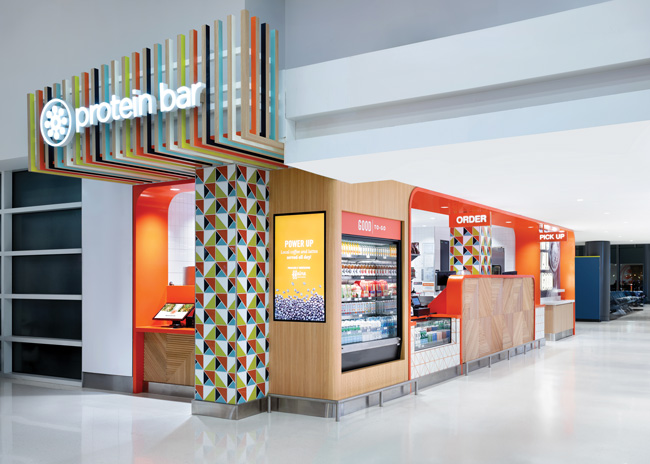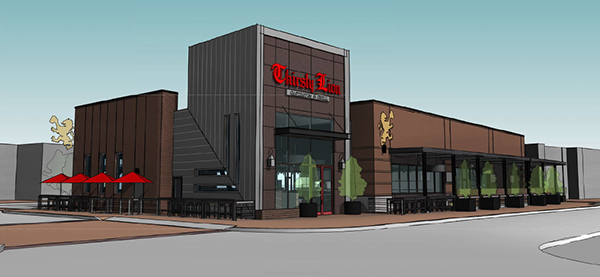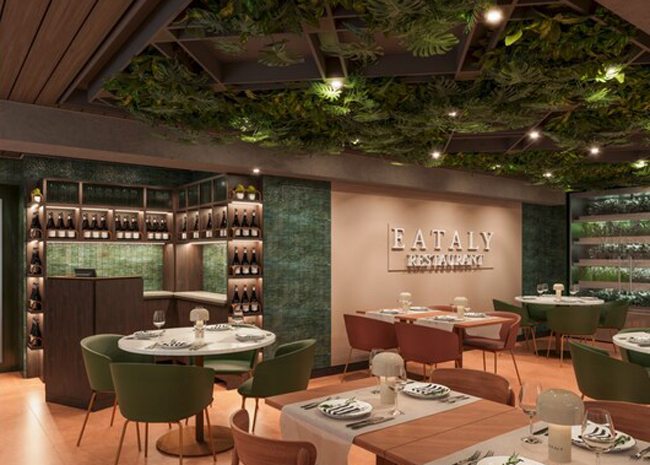Every day, nearly three million passengers fly into and out of U.S. airports, according to the Federal Aviation Administration.
Airports are a great opportunity for restaurant brands. Yes, these locations can take longer to open and can be more difficult to build. But the visibility they offer, and the higher sales per square foot, tend to be well worth it. There are many things to consider before opening an airport restaurant. Let’s learn from operators who’ve already done it.
Carefully Consider Location
One of the top places for a restaurant is by the gates, where people like to wait — ideally adjacent to several gates. “You want to be where people are congregating,” says Jared Cohen, chief operating officer, Protein Bar & Kitchen, Chicago. Another good spot is in a foodcourt. Travelers who arrive early look for these areas, which offer choice and often a communal seating area, says Amanda Friedman, director of design and development, Sambazon, a smoothie and bowl concept based in San Clemente, Calif.
Just inside security is another good spot for travelers who want to pass security and then relax. This is an especially good spot for a coffee concept as caffeine is often a necessity, says Marie Grimm, vice president of dining operations for Paradies Lagardère of Atlanta, Ga., an airport restaurant operator that works with a number of brands.
Paradies Lagardère used to operate a full-service Italian restaurant at Detroit Metropolitan Airport “but no one wants to sit down just beyond security,” says Grimm. They converted the spot to a Starbucks in 2021 and it’s now the busiest Starbucks in Michigan, per Grimm.
Sambazon tries to be near the right gates, “in an area that aligns with the passengers themselves,” says Friedman. “If you have a high-end concept you want to be nearer the premium airlines and more cost-effective concepts need to be near the low-cost airlines.”
 It’s important to allot sufficient storage space in floor plans for all of Sambazon’s fresh ingredients. Image courtesy of Zach Rolen
It’s important to allot sufficient storage space in floor plans for all of Sambazon’s fresh ingredients. Image courtesy of Zach Rolen
Factor in Design Differences
Airport locations get beaten up by luggage, strollers and the rush of nonstop travelers, so they need to be very durable.
Airport restaurants also often require more space for queues to accommodate busy travel times, says Kelly Roddy, CEO, WOWorks, St. Petersburg, Fla. The materials selected for furniture also need to be easy to clean and maintain, he adds.
And don’t forget acoustic considerations, Roddy says, “to create a comfortable dining experience amidst the terminal hustle and bustle.”
Beyond durable materials, Sambazon makes sure its airport concepts have high (around 6 inches) rubber bases/wainscotting to prevent them from scuffs and keep the concept looking well kept.
Also think about materials being stain-resistant and easy to wipe down, because there are a lot of spills, says Friedman.
A Diminutive Back of House
Typically, the back of the house in airport restaurants is very small, so concepts often streamline their menus to minimize the equipment they need.
“Every inch of the kitchen matters because efficiency is key and capacity is key,” says Chris McNamee, director of business development, Villa Restaurant Group, Morristown, N.J. “What’s more important is having seats, because each seat could net you $50,000 to $100,000 per year. So if you have equipment you don’t need or can do without, get rid of it.”
If it can, Villa moves its prep to a remote commissary, as close to the restaurant as possible. The brand takes on the expense of converting that prep space to be “food prep ready,” McNamee notes.
To keep equipment down, “consider your greatest menu hits,” says McNamee, so there’s more crossover for ingredients. This also helps with throughput as travelers have fewer decisions to make, and with storage since you have fewer SKUs. And if you need specialized equipment for a single menu item, consider eliminating it, unless it’s a signature item.
 Brands can work with airports to find a middle ground for signage between what each party would like to see. Image courtesy of Stephen Lamb, SP Real Estate Photography
Brands can work with airports to find a middle ground for signage between what each party would like to see. Image courtesy of Stephen Lamb, SP Real Estate Photography
Storage Considerations
Storage in airport restaurants is a critical consideration, so many brands use off-site storage, usually within the terminal but often some distance away.
Operators who use these spaces typically pay additional rent for them and build them out to meet their needs, says McNamee.
WOWorks uses vertical storage solutions and compact refrigeration units to maximize storage capacity while ensuring easy access to ingredients. “It’s imperative to have an efficient inventory management system to keep track of supplies, especially in a high-turnover environment like an airport,” says Roddy.
Protein Bar & Kitchen locations utilize off-site storage.
When Friedman designs a floorplan for Sambazon, she considers how often she’ll get deliveries to allot sufficient storage, especially since most ingredients for this concept are fresh.
Hiring and Retention
Working in an airport typically requires a long commute and the hassle of passing through security. On top of this, restaurants usually need to be open 90 minutes before the first flight and until the last one departs. Because of the long hours, wages in airport restaurants tend to be higher.
It can also be more difficult to hire. Staff must be cleared by the Transportation Security Administration (TSA) and get a background check, which can take 30 to 45 days, says Jim Schwandt, vice president of nontraditional business development, WOWorks. And the question is, are prospective employees willing to wait that long, he says.
Some operators pay future employees during that waiting time. Villa has never mandated pay for employees if there’s an opening delay “but it becomes the right thing to do,” McNamee points out.
“You can either let go 200 people or you pay them,” McNamee says. “You can’t be a people-first company with family values then put people out of a job.” Time and expense has been put into hiring and training these people, he points out. Three years ago a restaurant opening was pushed by five months and Villa had hired 200 people. In this instance, some worked temporarily in nearby locations, but in new markets, that’s not possible.
You also need to hire people who can handle these high-pressure, fast-paced environments, says Friedman. “They need stamina, focus, and the ability to work under pressure.”
Higher Operating Costs
As well as higher wages, there can be other increased costs, including additional storage or commissary areas, higher rents and pricier utilities.
There can also be logistical challenges that push up expenses. Delivery trucks might have to go through a consolidated receiving and distribution center, which costs money, McNamee points out. Operators also pay for trash removal. And pricing can be capped by the airport, he says. Operators are usually not allowed to charge more than 10% or 15% higher than the prices in streetside locations.
 Protein Bar & Kitchen’s bold colors make it stand out in an airport setting. Image courtesy of Daniel Kelleghan Photography
Protein Bar & Kitchen’s bold colors make it stand out in an airport setting. Image courtesy of Daniel Kelleghan Photography
Construction: Time and Money
Opening a restaurant in an airport often involves navigating a complex web of permitting and paperwork. Most construction must be completed at night to not disturb travelers, says Grimm, and contractors also have to pass TSA background checks.
There’s also the challenge of bringing tools and machinery to the job site, and they must be logged through security coming in and going out, Grimm explains. And often, you have to use airport-approved products.
You’re also often limited to a pool of approved general contractors for an airport, says Friedman, and these are often very busy people. And, you must pay contractors for the inconvenience of working at night.
Permitting and paperwork can take a lot longer too, Friedman says, and even though this might be protracted, restaurants still need to open on a specified date or incur fines.
Because of these challenges, Sambazon assembles as much as possible off-site. At Pittsburgh’s airport, for example, “we have our general contractor putting up the walls with the electricity and the plumbing at the airport and we have a vendor working off-site building wooden counters and installing the equipment,” Friedman says. “Then we’re just clipping it in at the airport to reduce the buildout costs.”
Airport-Specific Rules
Within each airport, restaurants have a level of uniformity to appear cohesive.
Rules are often mandated concerning signage. Airports can rule on which colors can be used, and whether a sign is backlit or downlit, says Schwandt.
Sometimes airports won’t allow signs above certain dimensions. But most of the time they’ll work with brands to find some middle ground “so a chain’s brand identity isn’t lost,” says McNamee, though he admits that it’s more often the brand compromising than the airport.
And sometimes logos must be stacked a certain way, which may not suit some brands, says Grimm. But often, she adds, “brands understand the value of being in the airport and are willing to make tweaks.”
Areas of the restaurant that face into the terminal may need to be altered, Schwandt adds. “Potentially your front counter can look the same but what faces out into the concourse may have to be considerably different and that applies to some of the finishes inside the space.”
Usually the finishes are the biggest conflict, says McNamee, who points out that airports “have really stringent rules in terms of durability, insulation and fire retardation.”
The Chicago airport wanted Protein Bar & Kitchen to add greenery to the outward part of its restaurant, which does not comply with the brand’s expression. So, the brand pushed back and eventually used its own bold color design palette but included elements like natural wood that were part of the airport’s desired design aesthetic.
Airport locations are usually a worthwhile investment for a brand and the increased long-term revenue at these spots tend to make the upfront headaches worth it.



